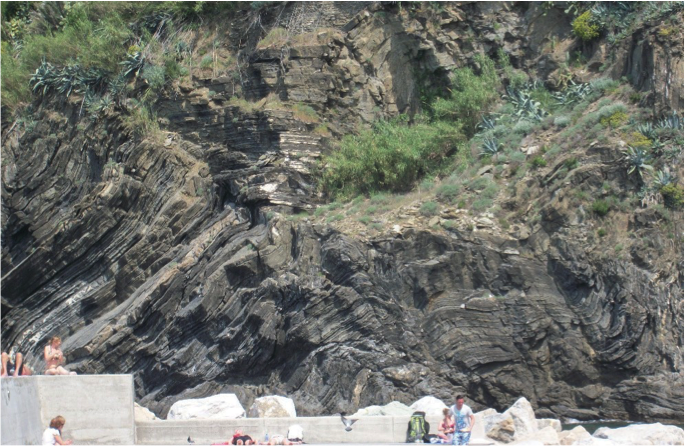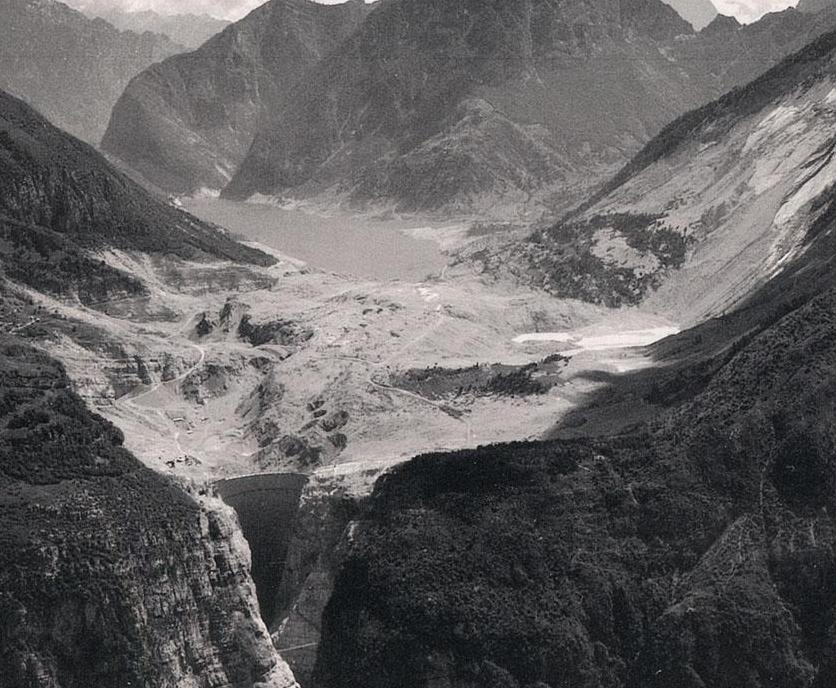Chapter 8. Geological Structures
Joyce M. McBeth, Karla Panchuk, Lyndsay R. Hauber, Tim C. Prokopiuk, & Sean W. Lacey (2018) University of Saskatchewan from Deline B, Harris R & Tefend K. (2015) “Laboratory Manual for Introductory Geology”. First Edition. Chapter 12 “Crustal Deformation” by Randa Harris and Bradley Deline, CC BY-SA 4.0. View source. Last edited: 8 Jan 2020
8.1 INTRODUCTION
Earth is an active planet shaped by dynamic forces. Forces generated by plate tectonics and other geological processes can build mountains, and crumple and fold rocks. As rocks respond to these forces, they undergo deformation, which results in changes in shape and/or volume of the rocks. The resulting features are termed geologic structures. This deformation can produce dramatic and beautiful scenery; for example, in Figure 8.1 the originally flat (horizontal) rock layers were deformed to form folds in the rocks. Structural geology is the subfield of geology in which scientists study the relationships between geological structures (such as folds and faults) and the processes (such as plate tectonics) that have shaped Earth’s crust through time.

Source: Randa Harris (2015) CC BY-SA 3.0 view source
Why is it important to study structures and deformation within the crust? These studies can provide us with a record of the geologic history in a region, and also give us clues to the broader geological processes happening globally through time. This information can be critical when searching for valuable mineral resources. The correct interpretation of features created during deformation helps geologists find oil and valuable metal ores in the petroleum and mining industry, respectively. It is also essential for engineers to understand the behavior of deformed rocks to create and maintain safely engineered structures (e.g., in open and underground mines, and for roads).
When engineers do not adequately consider geology in their planning – for example by excluding consideration of geological structures – disaster can strike. An example of this is the disaster that occurred at the Vajont Dam, Monte Toc, Italy in the early 1960s. The location was a poor choice for a dam: the valley was steep and narrow with undercut riverbanks at the base and the area surrounding the dam was prone to large landslides due to solution cavities in the limestone canyon walls which could fill with water and interbedded claystones that generated zones of structural weakness in the rocks. Thorough geological tests were not performed prior to construction. Shifting and fracturing of rock that occurred during the filling of the reservoir and faster downhill movement of surface geological deposits were warning signs that went unheeded. In 1963, a massive landslide in the area displaced much of the water in the dam, causing it to override the top of the dam and flood the many villages downstream, resulting in the deaths of almost 2,000 people (Figure 8.2).

Source: Unknown (1963) copyright expired. view source
There are two parts to this chapter overviewing geological structures:
Part I – strike, dip, and structural cross-sections: overview of the methods geologists use to describe geological structures, including strike and dip measurements, representations of geological structures on maps, how to construct geological cross-sections and measure the thicknesses of geologic units; and
Part II – folds, faults, and unconformities: overview of how to interpret and draw more complex geological structures on geological maps and cross-sections.
8.1.1 Learning Outcomes
After completing this chapter, you should be able to:
- Demonstrate an understanding of the concepts of strike and dip
- Use block diagrams to display geologic features
- Interpret a geologic map
- Create a geologic cross-section from a geologic map
- Understand the types of stress that rocks undergo, and their responses to stress
- Recognize the different types of folds and faults, and the forces that create them
8.1.2 Key Terms
- Anticline
- Basin
- Compressional forces
- Contact
- Dip
- Dip-slip fault
- Dome
- Geological cross-section
- Geological map
- Horst & graben structure
- Monocline
- Normal fault
- Reverse fault
- Shear forces
- Strain
- Stress
- Strike
- Strike-slip fault
- Syncline
- Tensional forces
- Thrust fault

